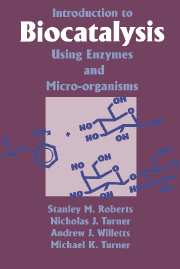Book contents
- Frontmatter
- Contents
- Preface
- Abbreviations
- 1 An historical introduction to biocatalysis using enzymes and micro-organisms
- 2 The interrelationships between enzymes and cells, with particular reference to whole-cell biotransformations using bacteria and fungi
- 3 Useful intermediates and end-products obtained from whole-cell/enzyme-catalysed hydrolysis and esterification reactions
- 4 Useful intermediates and end-products obtained from biocatalysed oxidation and reduction reactions
- 5 Useful intermediates and end-products obtained from biocatalysed carbon–carbon, carbon–oxygen, carbonnitrogen and carbon–chalcogen bond-forming reactions
- 6 The application of biocatalysis to the manufacture of fine chemicals
- Index
3 - Useful intermediates and end-products obtained from whole-cell/enzyme-catalysed hydrolysis and esterification reactions
Published online by Cambridge University Press: 04 August 2010
- Frontmatter
- Contents
- Preface
- Abbreviations
- 1 An historical introduction to biocatalysis using enzymes and micro-organisms
- 2 The interrelationships between enzymes and cells, with particular reference to whole-cell biotransformations using bacteria and fungi
- 3 Useful intermediates and end-products obtained from whole-cell/enzyme-catalysed hydrolysis and esterification reactions
- 4 Useful intermediates and end-products obtained from biocatalysed oxidation and reduction reactions
- 5 Useful intermediates and end-products obtained from biocatalysed carbon–carbon, carbon–oxygen, carbonnitrogen and carbon–chalcogen bond-forming reactions
- 6 The application of biocatalysis to the manufacture of fine chemicals
- Index
Summary
Introduction
Enzyme-catalysed hydrolysis and esterification reactions are the most commonly exploited biotransformations. There are two main reasons for this state of affairs. Firstly, the reactions are very easy to perform, and no special apparatus is required. Secondly, there is a wide range of hydrolase enzymes available from commercial suppliers. Furthermore, the stereoselectivities and chemoselectivities of the enzymes are well known, and the likely stereochemical outcomes of such enzyme-catalysed reactions on previously unused substrates are now becoming predictable.
There are many types of enzyme-catalysed hydrolysis reactions. In this chapter, the hydrolysis of esters and amides will be surveyed quite extensively, while the hydrolysis of nitriles and epoxides will be mentioned briefly at the end. The use of hydrolase enzymes in organic solvents will be discussed also, in connection with the preparation of esters and amides.
In a number of instances, whole-cell preparations have been preferred as catalysts for selected hydrolysis reactions; in most of these cases the micro-organisms are easy to grow and simple to handle and are utilized because of the low cost involved. These cases will be integrated into the discussion as and when appropriate.
Hydrolysis of esters
The enzyme-catalysed hydrolysis of simple esters (Scheme 3.1) takes place at temperatures around 35°C and at pH values around 7 (i.e. under very mild conditions). Such reactions have been studied in great detail, and the ways in which the enzymes catalyse the reactions are being investigated.
- Type
- Chapter
- Information
- Publisher: Cambridge University PressPrint publication year: 1995



